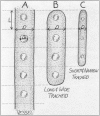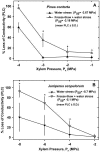Analysis of freeze-thaw embolism in conifers. The interaction between cavitation pressure and tracheid size
- PMID: 16377751
- PMCID: PMC1326058
- DOI: 10.1104/pp.105.067900
Analysis of freeze-thaw embolism in conifers. The interaction between cavitation pressure and tracheid size
Abstract
Ice formation in the xylem sap produces air bubbles that under negative xylem pressures may expand and cause embolism in the xylem conduits. We used the centrifuge method to evaluate the relationship between freeze-thaw embolism and conduit diameter across a range of xylem pressures (Px) in the conifers Pinus contorta and Juniperus scopulorum. Vulnerability curves showing loss of conductivity (embolism) with Px down to -8 MPa were generated with versus without superimposing a freeze-thaw treatment. In both species, the freeze-thaw plus water-stress treatment caused more embolism than water stress alone. We estimated the critical conduit diameter (Df) above which a tracheid will embolize due to freezing and thawing and found that it decreased from 35 microm at a Px of -0.5 MPa to 6 microm at -8 MPa. Further analysis showed that the proportionality between diameter of the air bubble nucleating the cavitation and the diameter of the conduit (kL) declined with increasingly negative Px. This suggests that the bubbles causing cavitation are smaller in proportion to tracheid diameter in narrow tracheids than in wider ones. A possible reason for this is that the rate of dissolving increases with bubble pressure, which is inversely proportional to bubble diameter (La Place's law). Hence, smaller bubbles shrink faster than bigger ones. Last, we used the empirical relationship between Px and Df to model the freeze-thaw response in conifer species.
Figures






References
-
- Alder NN, Pockman WT, Sperry JS, Nuismer S (1997) Use of centrifugal force in the study of xylem cavitation. J Exp Bot 48: 665–674
-
- Ameglio T, Ewers FW, Cochard H, Martignac M, Vandame M, Bodet C, Cruiziat P (2001) Winter stem xylem pressure in walnut trees: effects of carbohydrates, cooling and freezing. Tree Physiol 21: 387–394 - PubMed
-
- Bari SA, Hallet J (1974) Nucleation and growth of bubbles at an ice/water interface. J Glaciology 8: 489–529
-
- Cavender-Bares J (2005) Impacts of freezing on long-distance transport in woody plants. In NM Holbrook, MA Zwieniecki, eds, Vascular Transport in Plants. Elsevier Academic Press, San Diego, pp 401–424
-
- Cavender-Bares J, Holbrook NM (2001) Hydraulic properties and freezing-induced cavitation in sympatric evergreen and deciduous oaks with contrasting habitats. Plant Cell Environ 24: 1243–1256
Publication types
MeSH terms
Substances
LinkOut - more resources
Full Text Sources
Miscellaneous

